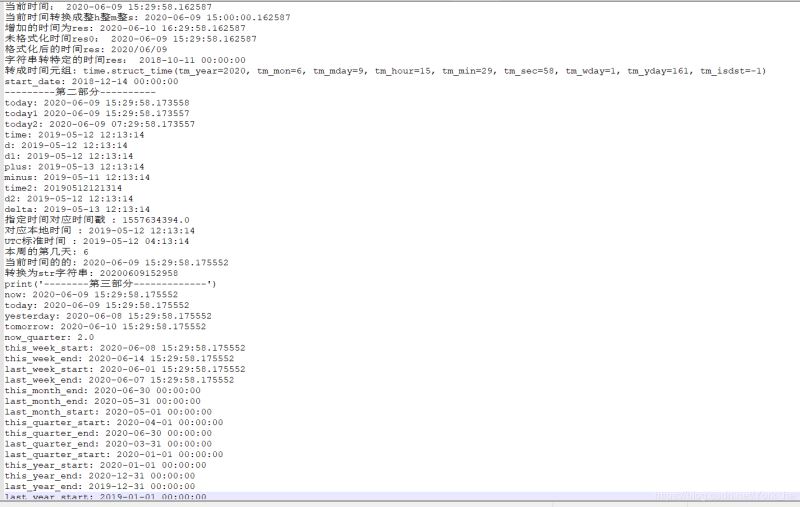具体代码如下所示: # 时间的替换import time,datetimetoday = datetime.datetime.today()print('当前时间:',today)print('当前时间转换成整h整m整s:',today.replace(minute=0, second=0))# 时间的加减res1 = today + dat
具体代码如下所示:
# 时间的替换
import time,datetime
today = datetime.datetime.today()
print('当前时间:',today)
print('当前时间转换成整h整m整s:',today.replace(minute=0, second=0))
# 时间的加减
res1 = today + datetime.timedelta(days=1,minutes=60)
print('增加的时间为res:',res1)
res0 = datetime.datetime.now()
print('未格式化时间res0:',res0)
# 将时间转字符串格式化
res2 = datetime.datetime.now().strftime("%Y/%m/%d")
print('格式化后的时间res:',res2)
# 字符串转时间
res3 = datetime.datetime.strptime('2018/10/11', "%Y/%m/%d")
print('字符串转特定的时间res:',res3)
# 转成时间元组
print('转成时间元组:',today.timetuple())
#日期0000时间格式转换为普通时间格式
str_time ='2018-12-14 00:00:00'
start_date = datetime.datetime.strptime(str_time, "%Y-%m-%d %H:%M:%S")
print('start_date:',start_date)
print('---------第二部分----------')
from datetime import datetime
from datetime import timedelta
# 1) 获取当前日期和时间
today = datetime.today() # 返回当前时间时分秒都为0
print('当前today:',today)
today1 = datetime.now() # 返回当前日期和时间
# now.hour # 时
# now.minute # 分
# now.isoweekday()# 返回的1-7代表周一--周日;
# now.weekday()# 返回的0-6代表周一--到周日
# 而标准格式种%w 1-6表示周一--周六,0代表周日
print('today1', today1 )
today2 = datetime.utcnow() # 返回当前东八区时间就是比当时时间少8个小时
print('today2:',today2)
# 2) 获取指定日期和时间,加减计算
time= datetime(2019, 5, 12, 12, 13, 14)
d= time + timedelta(weeks=0, days=0, hours=0, minutes=0, seconds=0, milliseconds=0, microseconds=0, )
#依次为 "周" "天", "时","分","秒","毫秒","微秒"
print('time:',time)
print('d:',d)
time1= "2019-5-12 12:13:14" # 字符串 日期
d1 = datetime.strptime(str(time1),'%Y-%m-%d %H:%M:%S')
plus= d1 + timedelta(days=1) # 加
minus = d1 - timedelta(days=1) # 减
print('d1:',d1)
print('plus:',plus)
print('minus:',minus)
time2= 20190512121314
d2 = datetime.strptime(str(time2),'%Y%m%d%H%M%S')
delta = d2 + timedelta(days=1)
print('time2:',time2)
print('d2:',d2 )
print('delta:',delta)
# 3) 日期datetime-timestamp 时间戳相互转
now_stamp = time.timestamp()
print('指定时间对应时间戳 :', now_stamp)
print('对应本地时间 :', datetime.fromtimestamp(now_stamp ))
print('UTC标准时间 :', datetime.utcfromtimestamp(now_stamp ))
print('本周的第几天:', datetime.fromtimestamp(now_stamp ).weekday())
# 4) datetime 时间 转换为str字符串
now = datetime.now()
print('当前时间的的:', now)
print('转换为str字符串:',now.strftime('%Y%m%d%H%M%S'))
print('--------第三部分-------------')
import datetime
from datetime import timedelta
now = datetime.datetime.now()
print('now:',now)
# 今天
today = now
print('today:',today)
# 昨天
yesterday = now - timedelta(days=1)
print('yesterday:',yesterday)
# 明天
tomorrow = now + timedelta(days=1)
print('tomorrow:',tomorrow)
# 当前季度
now_quarter = now.month / 3 if now.month % 3 == 0 else now.month / 3 + 1
print('now_quarter:',now_quarter)
# 本周第一天和最后一天
this_week_start = now - timedelta(days=now.weekday())
this_week_end = now + timedelta(days=6 - now.weekday())
print('this_week_start:',this_week_start)
print('this_week_end:',this_week_end)
# 上周第一天和最后一天
last_week_start = now - timedelta(days=now.weekday() + 7)
last_week_end = now - timedelta(days=now.weekday() + 1)
print('last_week_start:',last_week_start)
print('last_week_end:',last_week_end)
# 本月第一天和最后一天
this_month_start = datetime.datetime(now.year, now.month, 1)
month = now.month + 1
if month == 13:
month = 1
year = now.year + 1
this_month_end = datetime.datetime(now.year + 1, 1, 1) - timedelta(days=1)
print('this_month_end:',this_month_end )
else:
this_month_end = datetime.datetime(now.year, now.month + 1, 1) - timedelta(days=1)
print('this_month_end:',this_month_end )
# 上月第一天和最后一天
last_month_end = this_month_start - timedelta(days=1)
last_month_start = datetime.datetime(last_month_end.year, last_month_end.month, 1)
print('last_month_end:',last_month_end)
print('last_month_start:',last_month_start)
# 本季第一天和最后一天
month = (now.month - 1) - (now.month - 1) % 3 + 1
this_quarter_start = datetime.datetime(now.year, month, 1)
this_quarter_end = datetime.datetime(now.year, month + 3, 1) - timedelta(days=1)
print('this_quarter_start:',this_quarter_start)
print('this_quarter_end:',this_quarter_end)
# 上季第一天和最后一天
last_quarter_end = this_quarter_start - timedelta(days=1)
last_quarter_start = datetime.datetime(last_quarter_end.year, last_quarter_end.month - 2, 1)
print('last_quarter_end:',last_quarter_end)
print('last_quarter_start:',last_quarter_start)
# 本年第一天和最后一天
this_year_start = datetime.datetime(now.year, 1, 1)
this_year_end = datetime.datetime(now.year + 1, 1, 1) - timedelta(days=1)
print('this_year_start:',this_year_start)
print('this_year_end:',this_year_end)
# 去年第一天和最后一天
last_year_end = this_year_start - timedelta(days=1)
last_year_start = datetime.datetime(last_year_end.year, 1, 1)
print('last_year_end:',last_year_end)
print('last_year_start:',last_year_start)
打印结果如下:

总结
到此这篇关于python datetime时间格式的相互转换的文章就介绍到这了,更多相关python datetime时间格式的相互转换内容请搜索易盾网络以前的文章或继续浏览下面的相关文章希望大家以后多多支持易盾网络!
